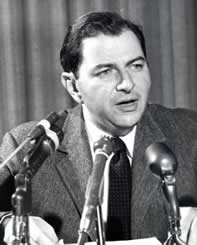

|

|
IN MEMORIAM
Martin Meyerson
Professor of City and Regional Planning, Emeritus
Acting Chancellor
UC Berkeley
1922 – 2007
Martin Meyerson, a brilliant scholar, creative institution builder, and formidable administrator, left his mark on the field of urban planning and on three major American universities. He died on June 2, 2007 of prostate cancer.
Born in 1922 in New York City, Meyerson grew up there and received his B.A. from Columbia University in 1942. In 1949, he was awarded the Master of City Planning degree from Harvard University. He began his academic career as an assistant professor of the social sciences at the University of Chicago in 1948, whence he moved to the Department of City and Regional Planning at the University of Pennsylvania in 1952. In 1957, he left Pennsylvania for Harvard University, where he headed the Joint Center for Urban Studies and served as acting dean of the Harvard Graduate School of Design. In 1963, Meyerson was appointed as the second dean of the newly formed College of Environmental Design at Berkeley, replacing William Wurster, who served only for a brief time.
Martin Meyerson excelled both as a scholar and as an administrator and institution builder. He came to urban planning after World War II, when the field was first beginning to develop within universities and there was a need for strong theoretical foundations. His book, Politics, Planning, and the Public Interest, coauthored with Edward C. Banfield, provided a key part of that foundation. Recognized immediately as a major contribution upon its publication in 1952, it placed planning firmly within politics and urban management. Expanding the design tradition, it became required reading for generations of students in the following decades. Meyerson’s subsequent scholarly work continued in this vein, always seeking to ground planning in practice and the urban context, while maintaining a strong theoretical underpinning.
Although Meyerson had demonstrated his qualities as a leader and administrator early in his career, his move to the University of California, Berkeley, in 1963 was to prove decisive. At that time, the College of Environmental Design, the first to bear that appellation, was just beginning to feel its way, attempting to integrate the fields of architecture, landscape architecture, and city and regional planning into a new synthesis. As dean, Meyerson understood that task and was bringing to it the power of his intellect and will when the 1964 storm of the Free Speech Movement (FSM) burst upon the Berkeley campus. The University’s administration was severely stressed, and in a remarkable meeting attended by over 1,000 faculty members, it lost their confidence, with the result that the then-chancellor resigned. In the emergency, Martin Meyerson took on the role of acting chancellor, calming the campus and restoring confidence. He was the faculty’s preferred candidate for appointment as chancellor, but the Regents selected another candidate.
From this point onward, Meyerson’s career was directed primarily toward institution building. In 1966, he became president of the State University of New York (SUNY) at Buffalo. At that time, the SUNY system was expanding rapidly, and SUNY Buffalo faced the major challenge of building a new university in an old industrial city undergoing severe decline. Through his innovation and leadership, Meyerson brought the university to a higher level. He then moved to the University of Pennsylvania in 1970, where he remained as president until 1981. At Pennsylvania, he again faced the challenge of a university in a deteriorating urban environment. Although an Ivy League school, the university was falling behind its peers. Under Meyerson’s guidance, Pennsylvania was virtually rebuilt physically, with the development of an integrated campus. At the same time, the university restored its endowment and upgraded its academic quality, consolidating a welter of programs into a School of Arts and Sciences, and internationalizing its offerings and student body. Much of Pennsylvania’s present status can be traced to those changes.
Following his retirement as president at Pennsylvania, Meyerson continued to teach, write, and contribute to international development efforts through the United Nations and other organizations. In this work, he was a consultant to several West African nations. He also served on numerous boards and foundations, and became a fellow of the American Academy of Arts and Sciences, fellow of the American Association for the Advancement of Science, and an academician of the Académie Européenne des Sciences, des Arts et des Lettres, and received over 20 honorary degrees, among his many honors.
Martin Meyerson is survived by his wife, Margy Ellin Meyerson; his sons Adam and Matthew; two daughters-in law, Sandra Meyers and Nina Shea; and seven grandchildren. His daughter, Laura, predeceased him.
Michael B. Teitz